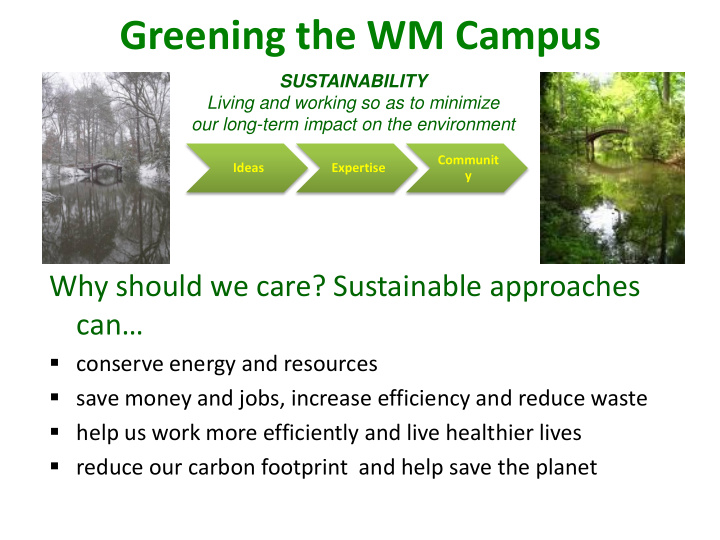



Greening the WM Campus SUSTAINABILITY Living and working so as to minimize our long-term impact on the environment Communit Ideas Expertise y Why should we care? Sustainable approaches can… conserve energy and resources save money and jobs, increase efficiency and reduce waste help us work more efficiently and live healthier lives reduce our carbon footprint and help save the planet
The President’s Committee on Sustainability (COS) • What is it? – COS is a committee of committed students, faculty, staff, and administrators volunteering and serving together to green WM – COS taps into the expertise and passion of the College – COS now involves more than 120 volunteers from throughout the College • How did it start? – COS was designed as a response to the President’s policy on sustainability and the student commitment to the Green Fee • What is its purpose? – “… to meet the College’s present needs without compromising the ability of future generations to meet their own.”
How is it organized? President Co-Chairs COS Lynda Butler, LAW Steering Dennis Taylor, VIMS STAC FOPS PEDS John Swaddle Bob Dillman Rowan Lockwood Biology Facilities Geology
Green Fees 2008/2009 • In the current academic year, the Green Fee generated $208,845
GREEN FEE PROJECTS Fall 2008 SPRING 2009 • • Energy Meters in Randolph Complex Tyler Hall HVAC Upgrade • • Light Sensors in SWEM Library Washington Hall HVAC Upgrade • • Campus Recycling Swem Library Towel Dispensers • • Solar Cell Project on Small Hall VIMS: Lighting in Hargis Library • • Stormwater Management Research Eco-House Energy Monitoring • Reduce Your Use-Athon • Campus Kitchen Green Containers • Eco-Ambassador Program • Green Roof Feasibility Study • GreenBoard • Reusable Takeout Pilot Study • VIMS: Green Team Motion Sensors • Waste Receptacle Pilot Study • Student Life Signage
2009 Summer Research Grants • Judi Sclafani and Tyler Koontz: Research on alternative cost options and possible obstacles to a self-sustaining campus-wide recycling program. Advisors: Rowan Lockwood (Geology) and Sandra Prior (Facilities Management) • Erica Hart: Research to develop a GIS map layer of the campus to inventory habitat, wildlife and ecosystem services. The layer will be incorporated into the integrated GIS mapping of the College. Advisors: Randy Chambers (Biology/Environmental Studies) and Stuart Hamilton (Center for Geospatial Analysis) • Connor Horne: Research in collaboration with Dining Services to develop a program for sustainable food procurement emphasizing increased reliance on locally produced foods, and sustainably grown agricultural products. Advisors: Eric Engstrom (Biology) and Larry Smith (Dining Services)
Looking Ahead In COS • COS leverages Green Fee $ to operate more efficiently – Washington Hall HVAC project will save $7,600/year and has a payback on investment of 3 years • COS leverages support from other campus, local and regional organizations to expand our impact • SEAC, Aramark, Back Porch Energy, CCAN, Real Food, VIMS Green Team – Aramark will fund 3 student interns ($20,000 in kind contribution) – Real Food is collaborating to increase our use of locally produced foods • COS stimulates the integration of teaching, research and service throughout the W&M community – Students are working with staff and faculty to establish Eco-House as an experiment in sustainable living – Eco-Ambassadors will pair students and staff to green departments and units across the College
Looking Ahead In COS • Our future agenda includes development of a green procurement guide, analysis of greenhouse gas data, evaluation of our recycling program, and continued greening of food services • Sustaining the COS effort – Build from community involvement – Strengthen the administrative structure – Improve communication and outreach
Recommend
More recommend